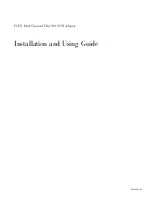
1.4 Trigger
12
U5303A User's Manual
1.4 Trigger
The trigger settings applied to the ADC card are used to determine at which time the device will start
recording data. The various trigger settings are outlined below.
Trigger source
The trigger source can be:
the signal applied to an input channel (internal triggering)
an external signal applied to the TRG IN front panel input connector (external triggering)
a software trigger (See
How to generate a software trigger? (page 86)
).
The different trigger modes are detailed in section
Trigger modes and time-stamps (page 63)
Trigger impedance & coupling
The U5303A has a fixed 50 Ω termination impedance with DC coupling.
Trigger input bandwidths
The bandwidth depends on the trigger source.
Channel trigger
The -3 dB bandwidth of the comparator of the channel triggers is from DC to 250 MHz. For input
signals with high frequency components, this means that the signal acquired and displayed doesn’t
correspond exactly to the signal seen from the trigger comparator input. Since, the signal seen on the
trigger comparator can be attenuated, this should be taken into account when selecting channel
triggers and specifying the trigger level.
External trigger
The external trigger input has a bandwidth from DC to 2 GHz.
Refer to section
How to set the external trigger? (page 89)
for additional information.
Trigger level
The trigger level specifies the voltage at which the selected trigger source will produce a valid trigger.
All trigger circuits have sensitivity levels that must be exceeded in order for reliable trigger to occur.
Both the external trigger input and channel triggers have a hysteresis of 5% of FSR (Full Scale
Range).
On the external trigger, the Full Scale Range FSR is ±5 V, therefore the ADC card will trigger on
signals with a peak-to-peak amplitude > 0.5 V.
When using the channel triggers, the trigger level must be set within Offset ± FSR .













































